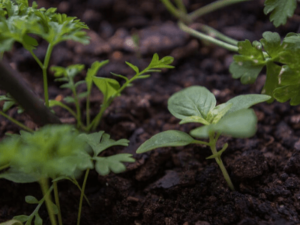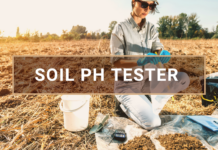
Soil pH affects plants in many different ways but when pH is the problem it’s not always easy to identify.
The signs are similar whether it is too high or too low. Your plants do not grow as they should, and the fertilizer probably doesn’t work.
There are some things to look for to determine if the pH of the soil is too high or too low so that you can treat the soil as necessary and again have happy, healthy plants. Let’s look at it closer.
What is pH and Why Is It Important?
PH is the measure of whether something is acidic or alkaline. For all living things, acidity is very important because most essential biological functions depend on having the right pH.
The pH-scale is between 0 and 14. The lower the number, the more acidic something is, the more alkaline it is, the greater the number.
Lemon juice, for example, is very acidic with a pH of about 2 while bleach is very alkaline with a pH of 13. Water has a pH of 7 and is neutral.
Acidity influences heavily the absorption and solubility that is really important for plant growth. It also has a significant impact on the organic materials that can survive in the soil, and how things like pesticides, metals, and contaminants are flushed out of the soil.
If the pH is too weak, is there any way to tell?
With time, soil pH naturally decreases if you don’t take care of it. It results in an excess of aluminum and iron, potassium, phosphorus, and magnesium shortages, and generally poor soil where nothing grows in.
While to be sure you should actively test your soil, there are a few things to look for that suggest it gets too acidic.
If you find that your yard has a lot of weeds and hasn’t used to be there, you probably need to increase the pH. Some weeds and moss-like acidic soil so if you start having an excess of them, it’s safe to say that the pH is weak.
Basically low pH makes plants really hard to grow. If you’re not sure what the problem is and fertilizer doesn’t seem to help, this could be an early indication of low pH.
Why? For what? Since fertilizer depends on the right pH. If it doesn’t work, there is certainly something out.
The most definite way to determine whether your pH in the soil is too low is to have it tested. There are kits that you can use to test at home, or you can take a sample to a garden center or a home improvement store and have them test it for you.
 Raising pH
Raising pH
The best way to boost the soil pH is to apply lime, which is alkaline. Lime comes in several different forms including sprayers, granules, and pellets. Which one you can use is a feature of your soil.
Pulverized lime is so small it can be consumed very quickly but it can be difficult to disperse uniformly. Granules and pellets are easier to transport but do not have the long-lasting pulverized lime effects.
Liquid forms are available but are not recommended. They can be absorbed too quickly, because they are water-soluble, and they can raise the pH too much, too fast.
Another option is the ashes of wood that are literally the ashes of burnt trees. Not only are alkaline enough for the wood to elevate the pH, but they also add micronutrients such as potassium, boron, and calcium.
Wood ash doesn’t work as fast as lime in the short term but can dramatically increase the pH over time. Be sure to monitor your soil carefully if you try wood ash.
When pH is too high, is there any way to tell?
If the pH is too high plants may lose the ability to efficiently absorb those nutrients. If you see yellow leaves, it’s a good sign your plants do not get what they need. In some plants, too, high pH may cause toxicity because it allows certain nutrients to build up in the soil, poisoning the plants.
High pH is also likely to partly throw off the microorganism balance in the soil because creatures like earthworms don’t like alkaline environments. They are stopping doing the essential work of extracting soil nitrogen.
In particular, high pH leads to high calcium, iron, and phosphate levels and iron, phosphate, and zinc deficiencies.
If the pH is too high the best way to tell is to test the soil. That’s really the only surefire way to figure out what’s wrong and what to do to correct it.
 Lowering pH
Lowering pH
There are a few things you can do to bring down the pH of soil. Try to add organic material to the soil first. You can use your own compost, or buy manure composted. As organic material breaks down, it is digested by bacteria which creates acidic by-products. In addition, such by-products carry down the pH.
Organic matter is going to work but will take some time. If you want something that works a little better, then another alternative is aluminum sulfate. When the aluminum sulfate dissolves, it is very acidic. It works fast but uses caution because it may be a little too effective.
Sulfur is one more way. It is less expensive than sulfate made from aluminum, acting more powerfully and slower. Sulfur is metabolized by bacteria in the soil, eventually turning it into sulfuric acid which lowers the overall pH. It may take a few months to have a significant effect.
pH and Growth
If your soil pH is too high or too low, it’s not always obvious but you’ll notice your plants are not behaving as they should be. They may not grow at all, maybe they turn yellow, or maybe weeds and mosses sprout up all over the place.
If you have attempted to apply fertilizer and have been ineffective, then pH is possibly to blame. If the pH is too low, fertilizer does not work because the acidic environment inhibits the absorption of the nutrients into the soil. If the pH is too high the plants can not absorb anything.
If you suspect a pH problem in your soil the first thing you can do is get it checked. This way, you’ll know exactly what you’re dealing with so that you can come up with a plan to fix it.

 Raising pH
Raising pH Lowering pH
Lowering pH




